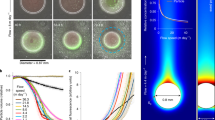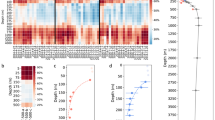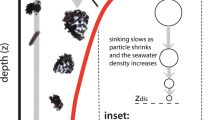Abstract
Oceanographers now recognize two distinct classes of particles in seawater, broadly categorized as suspended and sinking. The former class dominates the standing stock of particulate matter in the ocean and the latter class dominates the exchange between the surface waters and greater ocean depths1. The downward vertical flux of particulate organic matter (POM) in the open ocean exhibits a non-linear decrease with increasing water depth2–6, and greater than 75% of the net POM loss occurs in the upper 500 m of the water column6. Because sinking particles contain viable, metabolically active microorganisms7–12, the process of microbial decomposition is considered to be an important mechanism controlling POM flux. This model is consistent with the observed correspondence between POM flux and dissolved inorganic carbon concentrations13, and with the reported selective loss of biochemically labile compounds from sinking particles14–17. From our experiments, however, we conclude that the large sinking particles are, in general, poor habitats for bacterial growth and therefore unlikely sites for the active remineralization of organic matter. Our results require a shift in the emphasis of current ideas of particle decomposition from microbes attached to rapidly sinking particles to the microbial populations which are either free-living in the water column or attached to suspended (non-sinking) particulate matter.
This is a preview of subscription content, access via your institution
Access options
Subscribe to this journal
Receive 51 print issues and online access
$199.00 per year
only $3.90 per issue
Buy this article
- Purchase on Springer Link
- Instant access to full article PDF
Prices may be subject to local taxes which are calculated during checkout
Similar content being viewed by others
References
McCave, I. N. Deep-Sea Res. 22, 491–502 (1975).
Knauer, G. A., Martin, J. H. & Bruland, K. W. Deep-Sea Res. 26, 97–108 (1979).
Suess, E. Nature 288, 260–263 (1980).
Betzer, P. R., Showers, W. J., Laws, E. A., Winn, C. D., Ditullio, G. R. & Kroopnick, P. M. Deep-Sea Res. 31, 1–11 (1984).
Pace, M. L., Knauer, G. A., Karl, D. M. & Martin, J. H. Nature 325, 803–804 (1987).
Martin, J. H., Knauer, G. A., Karl, D. M. & Broenkow, W. W. Deep-Sea Res. 34, 267–285 (1987).
Caron, D. A., Davis, P. G., Madin, L. P. & Sieburth, J. McN. Science 218, 795–797 (1982).
Ducklow, H. W., Kirchman, D. L. & Rowe, G. T. Appl. envir. Microbiol. 43, 769–776 (1982).
Ducklow, H. W., Hill, S. M. & Gardner, W. D. Continental Shelf Res. 4, 445–464 (1985).
Silver, M. W., Gowing, M. M., Brownless, D. C. & Corliss, J. O. Nature 309, 246–248 (1984).
Karl, D. M. & Knauer, G. A. Deep-Sea Res. 31, 221–243 (1984).
Taylor, G. T., Karl, D. M. & Pace, M. L. Mar. Ecol. Prog. Ser. 29, 141–155 (1986).
Viecelli, J. A. J. geophys. Res. 89, 8194–8196 (1984).
Wakeham, S. G. et al. Nature 286, 798–800 (1980).
De Baar, H. J. W., Farrington, J. W. & Wakeham, S. G. J. mar. Res. 41, 19–41 (1983).
Wakeham, S. G., Lee, C., Farrington, J. W. & Gagosina, R. B. Deep-Sea Res. 31, 509–528 (1984).
Lee, C. & Cronin, C. J. mar. Res. 42, 1075–1097 (1984).
Fellows, D. A., Karl, D. M. & Kanauer, G. A. Deep-Sea Res. 28, 921–936 (1981).
Karl, D. M. Microbiol. Rev. 44, 739–796 (1980).
Andrews, C. A., Karl, D. M., Small, L. F. & Fowler, S. W. Nature 307, 539–541 (1984).
Alldredge, A. L. & Youngbluth, M. J. Deep-Sea Res. 32, 1445–1456 (1985).
Alldredge, A. L., Cole, J. J. & Caron, D. A. Limnol. Oceanogr. 31, 68–78 (1986).
Yayanos, A., Dietz, A. S. & Van Boxtel, R. Science 205, 808–810 (1979).
Deming, J. W., Tabor, P. S. & Colwell, R. R. Microb. Ecol. 7, 85–94 (1981).
Author information
Authors and Affiliations
Rights and permissions
About this article
Cite this article
Karl, D., Knauer, G. & Martin, J. Downward flux of particulate organic matter in the ocean: a particle decomposition paradox. Nature 332, 438–441 (1988). https://doi.org/10.1038/332438a0
Received:
Accepted:
Issue Date:
DOI: https://doi.org/10.1038/332438a0
This article is cited by
-
Microbes contribute to setting the ocean carbon flux by altering the fate of sinking particulates
Nature Communications (2022)
-
Metapangenomics reveals depth-dependent shifts in metabolic potential for the ubiquitous marine bacterial SAR324 lineage
Microbiome (2021)
-
The decomposition rate of the organic carbon content of suspended particulate matter in the tropical seagrass meadows
Acta Oceanologica Sinica (2021)
-
Short-term dynamics of nutrients, planktonic abundances, and microbial respiratory activity in the Arctic Kongsfjorden (Svalbard, Norway)
Polar Biology (2021)
-
Distribution and quantification of bioluminescence as an ecological trait in the deep sea benthos
Scientific Reports (2019)
Comments
By submitting a comment you agree to abide by our Terms and Community Guidelines. If you find something abusive or that does not comply with our terms or guidelines please flag it as inappropriate.



